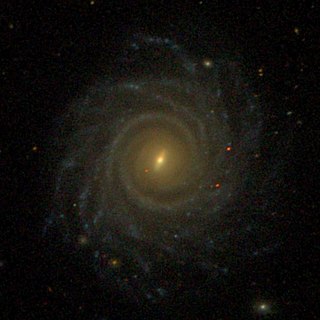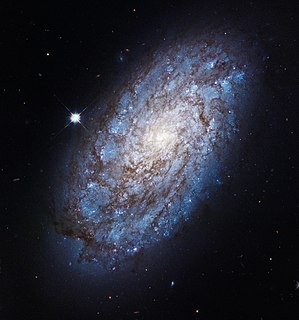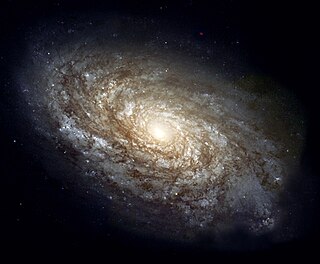 W
WA flocculent spiral galaxy is a type of spiral galaxy. Unlike the well-defined spiral architecture of a grand design spiral galaxy, flocculent galaxies are patchy, with discontinuous spiral arms. Self-propagating star formation is the apparent explanation for the structure of flocculent spirals. Approximately 30% of spirals are flocculent, 10% are grand design, and the rest are referred to as "multi-armed". The multiple-arm type is sometimes grouped into the flocculent category.
 W
WNGC 2397 is a flocculent spiral galaxy located in the southern Volans constellation, about one degree to the SSE of Delta Volantis. English astronomer John Herschel discovered the galaxy on February 21, 1835. It is located at a distance of approximately 69 million light years from the Sun, and is a member of the small NGC 2442 group that includes NGC 2434.
 W
WNGC 2775 is a spiral galaxy in the northern constellation of Cancer, located at a distance of 67 megalight-years from the Milky Way. It was discovered by William Herschel in 1783. NGC 2775 belongs to the Antlia-Hydra Cluster of galaxies and is the most prominent member of a small galaxy group known as NGC 2775 group, part of the Virgo Supercluster, along with the Local Group. Other members of the NGC 2775 group include NGC 2777 and UGC 4781.
 W
WNGC 2841 is an unbarred spiral galaxy in the northern circumpolar constellation of Ursa Major. It was discovered on 9 March 1788 by German-born astronomer William Herschel. J. L. E. Dreyer, the author of the New General Catalogue, described it as, "very bright, large, very much extended 151°, very suddenly much brighter middle equal to 10th magnitude star". Initially thought to be about 30 million light-years distant, a 2001 Hubble Space Telescope survey of the galaxy's Cepheid variables determined its distance to be approximately 14.1 megaparsecs or 46 million light-years. The optical size of the galaxy is 8.′1 × 3.′5.
 W
WNGC 3521 is a flocculent intermediate spiral galaxy located around 26 million light-years away from Earth in the constellation Leo. It has a morphological classification of SAB(rs)bc, which indicates that it is a spiral galaxy with a trace of a bar structure (SAB), a weak inner ring (rs), and moderate to loosely wound arm structure (bc). The bar structure is difficult to discern, both because it has a low ellipticity and the galaxy is at a high inclination of 72.7° to the line of sight. The relatively bright bulge is nearly 3/4 the size of the bar, which may indicate the former is quite massive. The nucleus of this galaxy is classified as an HII LINER, as there is an H II region at the core and the nucleus forms a low-ionization nuclear emission-line region.
 W
WNGC 3883 is a large low surface brightness spiral galaxy located about 330 million light-years away in the constellation Leo. NGC 3883 has a prominent bulge but does not host an AGN. The galaxy also has flocculent spiral arms in its disk. It was discovered by astronomer William Herschel on April 13, 1785 and is a member of the Leo Cluster.
 W
WNGC 4212 is a flocculent spiral galaxy with LINER activity located about 53 million light-years away in the constellation Coma Berenices. The galaxy was discovered by astronomer William Herschel on April 8, 1784 and was listed in the NGC catalog as NGC 4208. He then observed the same galaxy and listed it as NGC 4212. Astronomer John Louis Emil Dreyer later concluded that NGC 4208 was identical to NGC 4212. NGC 4212 is a member of the Virgo Cluster.
 W
WNGC 4237 is a flocculent spiral galaxy located about 60 million light-years away in the constellation Coma Berenices. The galaxy was discovered by astronomer William Herschel on December 30, 1783 and is a member of the Virgo Cluster. It is also classified as a LINER galaxy and as a Seyfert galaxy.
 W
WNGC 4294 is a barred spiral galaxy with flocculent spiral arms located about 55 million light-years away in the constellation Virgo. The galaxy was discovered by astronomer William Herschel on March 15, 1784 and is a member of the Virgo Cluster.
 W
WNGC 4298 is a flocculent spiral galaxy located about 53 million light-years away in the constellation Coma Berenices. The galaxy was discovered by astronomer William Herschel on April 8, 1784 and is a member of the Virgo Cluster.
 W
WNGC 4414 is an unbarred spiral galaxy about 62 million light-years away in the constellation Coma Berenices. It is a flocculent spiral galaxy, with short segments of spiral structure but without the dramatic well-defined spiral arms of a grand design spiral. In 1974 a supernova, SN 1974G, was observed and was the only supernova in this galaxy to be recorded until June 7, 2013 when SN 2013df was discovered at magnitude 14.
 W
WNGC 4689 is a spiral galaxy located about 54 million light-years away in the constellation of Coma Berenices. NGC 4689 is also classified as a LINER galaxy. NGC 4689 is inclined at an angle of about 36° which means that the galaxy is seen almost face-on to the Earth's line of sight. NGC 4689 was discovered by astronomer William Herschel on April 12, 1784. The galaxy is a member of the Virgo Cluster.
 W
WNGC 7083 is an unbarred spiral galaxy located about 134 million light-years away in the constellation of Indus. It is also classified as a flocculent spiral galaxy. NGC 7083 was discovered by astronomer James Dunlop on August 28, 1826.